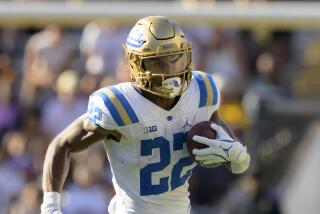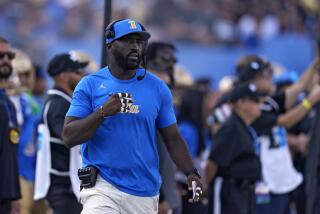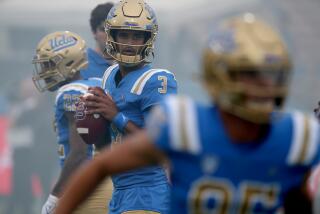More college football teams making the dash to add hurry-up offenses

- Share via
Football is serious business but offers enough unintentionally funny moments to occasionally split your sides.
Labor Day weekend’s laugh track featured California’s coaching staff accusing the opponent of faking injuries to slow down its offense.
Now wasn’t that rich, as in Rodriguez.
First-year Cal Coach Sonny Dykes, who led the nation’s highest flying offense last year at Louisiana Tech, thought Northwestern players were purposely cramping up to cramp Cal’s style — and the fact that Cal somehow managed to run 99 plays in a 44-30 loss didn’t dampen the premise.
What an outrage — except in 2010 it was Oregon accusing Cal, under then-coach Jeff Tedford, of the same tactics.
The allegations were despicable — but true: Cal suspended defensive line coach Tosh Lupoi one game for admitting he instructed players to flop. The saga ended with Lupoi keeping his job and Cal Athletic Director Sandy Barbour saying “we make mistakes in life a lot.”
Lupoi is now the defensive line coach at Washington, where he must contemplate whether to instruct his Huskies defenders to take falls — in practice.
That’s right, Washington is the latest team to go up-tempo, and boy did it work in Saturday’s 38-6 thrashing of Boise State in Seattle.
Washington ran 88 plays in a win that was so impressive one voter in the Associated Press poll jumped the Huskies from unranked to No. 8 on his ballot.
Washington Coach Steve Sarkisian changed the pace in an attempt to get his program off the 7-6, 7-5, 7-6 record pattern. Sarkisian started tinkering with the idea a couple years ago after conversations with then-Houston coach Kevin Sumlin.
So many teams are going fast even the Founding Fathers of Frenetic are having a tough time keeping up.
Rich Rodriguez, who helped revolutionize the concept at West Virginia, is now the coach at Arizona. His team ran only 47 plays in a 35-0 win over Northern Arizona. “Forty-seven plays,” Rodriguez said on this week’s Pac-12 Conference coaches’ teleconference. “We normally get that in a half.”
Rodriguez swore it was a fluke and that it would never happen again. “It was a lot more fun when we were one of the few teams that did it 10 or 15 years ago,” he added.
Believe it or not, RichRod says the infrastructure of the game is catching up with the pace of the game, although up-tempo offenses are disadvantaged in high-profile bowl games where there are numerous TV timeouts.
Oregon’s offense, in the 2010 season title game, wasn’t stopped by Auburn as much as it was stopped by commercials.
Rodriguez says officials and everyone else has become more attuned to the speed of the game.
“I had to remind our chain crew that they had to get in better shape because they were a little slow spotting the ball and bringing the chains down,” Rodriguez said. “And so we had an elderly gentleman that struggled at first and I told him, ‘Listen you’re going to have to get in shape because we’re going to need you to pull those chains a little faster.’ And he did. He said, ‘Coach, I’ll be ready by the next season for sure.’”
The problem with up-tempo and the faking of injuries is trying to prove an opponent is purposely attempting to subvert fair play.
Coach Pat Fitzgerald was insulted that Cal would accuse a fine program such as Northwestern’s of such chicanery. It was a hot night in Berkeley last Saturday and players certainly could have seized up from dehydration. But how do you know?
“Really officials don’t have control over it,” Dykes said this week. “There’s really nothing you can do. It’s really as much of an ethical question as anything.”
So what can be done? Dykes said the NCAA needs to examine whether rules should be enacted to protect injured and/or “injured” players.
As it stands, a player must leave the field for one play if the clock is stopped because of his injury. Dykes suggested the sit-out period be extended to multiple plays or the remainder of the series.
In some instances, that would protect the legitimately injured and root out the fakers.
“Everybody is interested in player safety,” Dykes said, “and when somebody requires the attention of a training staff or medical staff, I think that player needs to have the proper amount of time to be diagnosed.”
The issue isn’t going away because up-tempo offenses aren’t going away. Schools that don’t play up-tempo are going to have to adjust; the good ones already are. Stanford, a plodding team with bygone-era philosophies, is the defending Rose Bowl champion.
How did Stanford fare against fast last year at Oregon? The Cardinal held the Ducks to 405 yards and 14 points in a 17-14 overtime win.
Stanford had 411 yards and ran more plays than Oregon, 82 vs. 77.
Notre Dame Coach Brian Kelly used that game as an example of how speed can be counteracted.
“Stanford figured out a way to get their calls in and play really fast defense, and they caught up to that fast-tempo offense,” Kelly said. “I’m of the opinion that if you can do it on offense, you can do it on defense.”
If all else fails, though, fall down and scream for the trainer.
More to Read
Go beyond the scoreboard
Get the latest on L.A.'s teams in the daily Sports Report newsletter.
You may occasionally receive promotional content from the Los Angeles Times.











